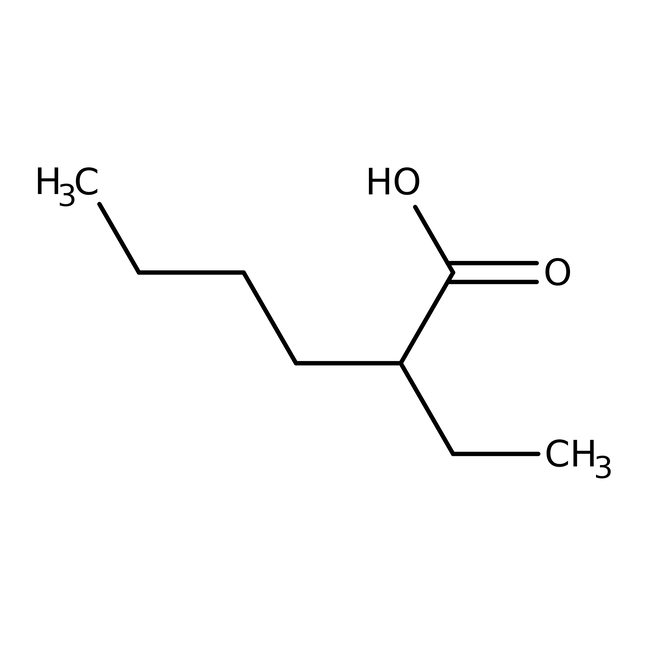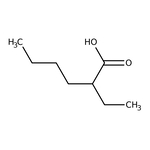Search Thermo Fisher Scientific
Thermo Scientific Chemicals
2-Ethylhexanoic acid, 99%
CAS: 149-57-5 | C8H16O2 | 144.214 g/mol
Catalog number ALFA12644.AP
Price (MYR)
317.00
EA
Quantity:
500 mL
Price (MYR)
317.00
EA
Specifications
Chemical Name or Material2-Ethylhexanoic acid
CAS149-57-5
Health Hazard 1H302-H312-H314-H361d
Health Hazard 2GHS H Statement
H361-H302-H312
Suspected of damaging fertility or the unborn child.
Harmful if swallowed.
Harmful in contact with skin.
H361-H302-H312
Suspected of damaging fertility or the unborn child.
Harmful if swallowed.
Harmful in contact with skin.
Health Hazard 3P201-P202-P260-P264b-P270-P280-P301+P312-P303+P361+P353-P304+P340-P305+P351+P338-P308+P313-P310-P312-P330-P363-P501c
View more
2-Ethylhexanoic acid is used in the preparation of metal derivatives, which act as a catalyst in polymerization reactions. For example, tin 2-ethylhexanoate is used in the manufacturing of poly(lactic-co-glycolic acid). It is also used as a stabilizer for polyvinyl chlorides. It is also involved in solvent extraction and dye granulation. Further, it is used to prepare plasticizers, lubricants, detergents, flotation aids, corrosion inhibitors and alkyd resins. In addition to this, it serves as a catalyst for polyurethane foaming.
This Thermo Scientific Chemicals brand product was originally part of the Alfa Aesar product portfolio. Some documentation and label information may refer to the legacy brand. The original Alfa Aesar product / item code or SKU reference has not changed as a part of the brand transition to Thermo Scientific Chemicals.
Applications
2-Ethylhexanoic acid is used in the preparation of metal derivatives, which act as a catalyst in polymerization reactions. For example, tin 2-ethylhexanoate is used in the manufacturing of poly(lactic-co-glycolic acid). It is also used as a stabilizer for polyvinyl chlorides. It is also involved in solvent extraction and dye granulation. Further, it is used to prepare plasticizers, lubricants, detergents, flotation aids, corrosion inhibitors and alkyd resins. In addition to this, it serves as a catalyst for polyurethane foaming.
Solubility
Miscible with water.
Notes
Incompatible with bases, oxidizing agents and reducing agents.
2-Ethylhexanoic acid is used in the preparation of metal derivatives, which act as a catalyst in polymerization reactions. For example, tin 2-ethylhexanoate is used in the manufacturing of poly(lactic-co-glycolic acid). It is also used as a stabilizer for polyvinyl chlorides. It is also involved in solvent extraction and dye granulation. Further, it is used to prepare plasticizers, lubricants, detergents, flotation aids, corrosion inhibitors and alkyd resins. In addition to this, it serves as a catalyst for polyurethane foaming.
Solubility
Miscible with water.
Notes
Incompatible with bases, oxidizing agents and reducing agents.
RUO – Research Use Only
General References:
- Sun, T.; Qi, M.; Fu, R. Perhydroxylcucurbit[6]uril as a highly selective gas chromatographic stationary phase for analytes of wide-ranging polarity. J. Sep. Sci. 2015, 38 (5), 821-824.
- Mochalski, P.; Theurl, M.; Sponring, A.; Unterkofler, K.; Kirchmair, R.; Amann, A. Analysis of Volatile Organic Compounds Liberated and Metabolised by Human Umbilical Vein Endothelial Cells (HUVEC) In Vitro. Cell Biochem. Biophys. 2015, 71 (1), 323-329.



